Remote Work for Actuaries
By James Clark
Executive Summary
The COVID-19 Pandemic has disrupted many facets of life, including a shift to near total remote work for much of the insurance industry. A survey in the summer of 2020 to members of the Leadership and Development Section of the Society of Actuaries targeted specific issues faced by those in the actuarial profession in a remote environment. This report provides insights on the issues and possible approaches to dealing with them from an actuarial perspective, with specific insight and commentary from SOA members Ravi Bhagat, FSA, MAAA, actuarial director at KPMG; and Shelley Webb, ASA, MAAA, director of Actuarial at Cambia Health Solutions.
Key takeaways in the new working environment:
- Leaders need to support employees with technical challenges like setting up a home office and making good internet connections.
- Leaders also need to act intentionally to help employees make and maintain personal connections with coworkers.
- Set up virtual chat rooms, encourage the creation of virtual exam study groups, and establish social opportunities like virtual happy hours or game nights.
- Encourage and facilitate opportunities for employees to see and interact with senior leaders.
- Adopt technology solutions for connecting people across geographies and across personality types.
- Leaders must be mindful of the culture they’re fostering. For instance, being intentional, allowing ourselves to be vulnerable and employing humor are key success factors in a remote environment.
- Future leaders need to be proactive in developing their people networks and building their personal brand.
- Promote their unique value through honest and candid interactions.
- Leverage shared connections with others beyond working relationships.
- Communicate realistic expectations about work/life balance and other issues.
- Future leaders also need to recognize the importance of managing personal and team accountability, with a primary tactic of embracing open and honest communication.
- Be more present at both work and home by focusing on the current moment (and not being distracted).
Introduction
The advent of the COVID-19 Pandemic in early 2020 has been a disruptive force in people’s personal lives, the business community, and the economy throughout the world. One impact has been the near-total shift to remote work for many industries, and those working in the actuarial profession have found themselves facing a variety of unique challenges working remotely.
In early June of this year, the Leadership and Development Section Council sent out a survey on remote work for actuaries to members of the section. The survey had a series of questions on challenges being faced by actuaries specifically in a remote work environment and sought comments and suggestions for actuaries to succeed in this new environment. Over 100 actuaries shared their experiences and insights. Responses came from coast-to-coast in both the U.S. and Canada, and at least a couple from outside North America. 46.7 percent of respondents identified themselves as hiring managers, while 42.9 percent identified themselves as not being hiring managers. The remainder did not specify.
A few themes emerged that, while not necessarily surprising, did lend some credence to generally assumed elements of the remote work environment. Comments and concerns essentially broke down into two main categories: people and technology. Common people issues revolve around relationship building, dealing with distractions, onboarding, culture building, and work-life balance. Technology issues include hardware, software, connectivity and office setup.
Interestingly, the items of greatest concern were related to the human element of remote work. These issues in some ways are the easiest to address, but in other ways, the hardest to undertake. Respondents voiced both challenges faced and how they are meeting those challenges through communication, technology, hiring, and general management.
The primary content of this report is written addressing the themes from the survey within the context of skills and tools needed by both current leaders and future leaders. The next few sections were authored with contributions from Shelley Webb and Ravi Bhagat.
Challenges and Opportunities for Current Leaders, Author: Shelley Webb
Backdrop
I used to work 3–4 days a week in our Seattle office, with regular work-from-home days and occasional travel to our Portland office, where the company is headquartered. I had staff that worked in both locations, but also full-time remote staff. When I transitioned to full-time remote in early March, life wasn’t that different since I was always on calls with people in another location anyway, and I had a home office in place. So, whew! And that’s natural, to think about our own current situation first. But as people-leaders, we need to scan the field and see what else is at play—I had five people in my department who had been here less than a year, one hired after the remote-work directive, 11 people studying for exams, seven staff with young children also at home, and a few who had never worked at home (home office translated into sofa + laptop).
Challenges and Opportunities
Consistent with the survey results, some of the challenges that surfaced were technical challenges—the need to support staff in setting up their home office and internet connections, for example—but many were a little softer in nature. These include things we probably assumed just happened naturally by virtue of being in an office setting—the development of peer networks, receiving impromptu feedback on problem-solving approaches, and engagement with our coworkers. Through the process of looking intentionally at each of these connection challenges, I became aware that my assumptions were steeped in my own bias, a somewhat extroverted actuary with an established personal network.
For the introverted actuarial student new to the company, physically sitting in an office (as was common in the pre-pandemic world) does not naturally overcome these challenges, and the actuaries who were already working remotely have been consistently just left to their own devices. By implementing strategies for connecting people in this “new” remote work environment, we are actually creating a more equitable and accessible work environment for everyone.
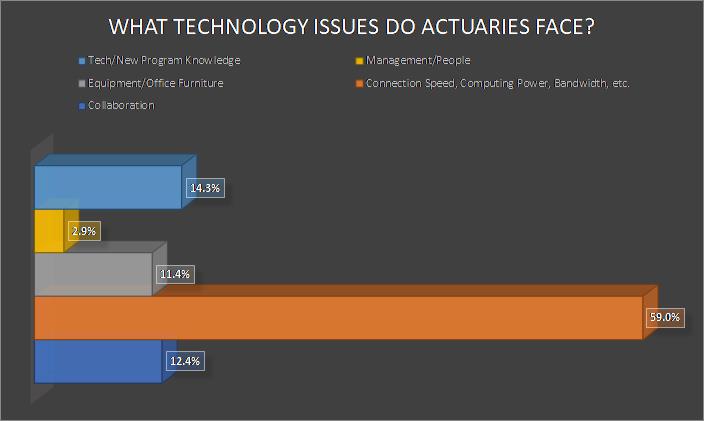
Selected Comments (105 Responses):
- “Bandwidth from home is not always the best. Our employer has been using virtual machines, which allow more calculation intensive work to be performed on the company server (virtual machine) and only use the VPN/bandwidth to send images and commands back and forth between the employee’s machine the and company server. This allows for faster processing.”
- “I think I’ve been on every virtual meeting platform that exists. Some work better than others. Often ran into problems when someone on the meeting had a weak internet connection causing either garbled sound or slow loading of documents, or a complete disconnect. Calling into meetings on the phone with sound turned off often works better. Even then there can/would be issues of feedback.”
- “Many actuarial models require higher than average computing power. That computing power is harder to tap into with laptops or through VPN/Citrix. So far, we’ve ended up requesting access to more machines to help deal with lag and give more flexibility.”
- “Accessing large files from network drives is slower when remote. For testing/R&D purposes, it’s often faster to copy these to the C:\Temp drive and use them there. This is especially true for Microsoft Access databases or large Excel spreadsheets. This can be overcome by storing data in SQL Server databases or text files that are smaller.”
- “Introverted actuaries are more likely to burn out with lots of video calls. Recognizing that video is not required for all calls is important (but prioritize when it is important).”
- “Technical debt coming from legacy processes/languages. Mainframe processes, COBOL, Perl, and APL are still commonly used for production, but are increasingly difficult to maintain as the pool of developers familiar with these shrinks. Documentation for these processes may be non-existent or use significant jargon that is difficult for a non-expert to understand. This can be overcome by periodically evaluating the technology stack and phasing out obsolete programs and processes if possible.”
- “I think communication in general remains a focus but is challenged in different ways now. Maintaining cross-functional relationships, over-communicating while not overwhelming recipients, leading effective meetings (cross-talking is a new, different challenge) are all areas we don't excel in. The solution is effort, but that effort takes away from ‘getting things done.’”
- “One-on-one meetings to keep up to date and keep people on task: have scheduled more frequent one-on-ones and team meetings, and more impromptu meetings online (Microsoft Teams).”
- “Productivity on a laptop—providing them with a full keyboard, mouse, and two monitors to create a home office.”
- “Equipment failure such as headphones and free USB expanders from conferences—started using audio through the laptop instead of headphones and ordered a better-quality USB expander.”
- “Hiring and onboarding: higher emphasis on planning before start date, importance of system access, and regular (scheduled) contact with supervisors and co-workers in the first month.”
Culture Adaptation/Personal Connections was the top challenge of onboarding a new employee remotely.
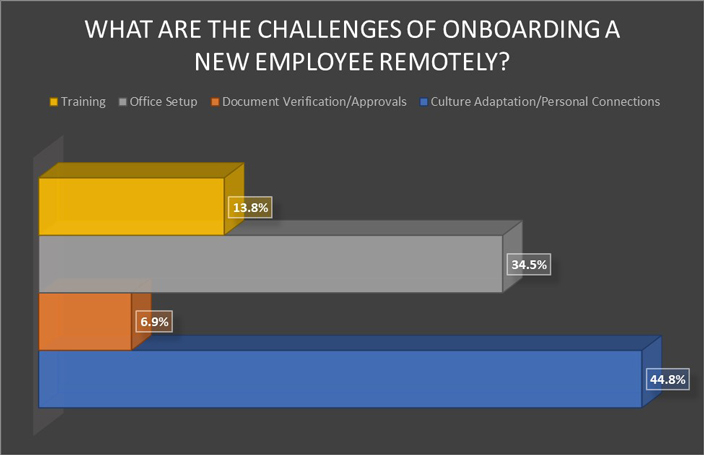
Selected Comments (29 Responses):
- “Solutions: mail equipment to home address; use virtual meetings to meet with IT for computer set-up and to meet with team members and leaders.”
- “Over-communicate and make time for relationship building.”
- “Planning ahead for onboarding and the first few weeks of work, need to make sure they have scheduled contact with not just hiring manager but coworkers and other levels of management at first. Was more of a team effort, can’t leave the new hire out to fend for themselves as much as we could before. Also, instead of sending just the regular org chart, I made a custom one with pictures of all team members and personal phone numbers.”
- “Need to get HR and IT involved early in the process.”
- “Teaching in process and initial systems and other administrative requirements. Ask younger and less exposed actuaries to handle much of process.”
- “We started a new intern in June. We spent an hour discussing how to connect remotely (in person), then sent them “home.” The project was defined with a remote possibility in mind, so preparation beforehand was key.”
Creating connection opportunities for staff is not the only challenge—remote work has also likely changed how you engage with your senior leadership, another important aspect of your personal career development. While I am missing the impromptu hallway conversations at my office location, I am not missing the “only person on the phone while everyone else is in the room” dynamic that used to exist when engaging with leadership at another location. Now, in meetings, everyone is sitting at the same table. Take advantage of that! Keep a nice shirt nearby, turn your video on, and claim your seat. If you find that exposure to senior leadership has decreased significantly, brainstorm ways you can re-establish those connections both for yourself and for your employees. Without intention, the connection is more likely to get lost.
Solutions—Role of Technology
As actuaries, we are often working our way through new problems, and it can be helpful to walk through our thought process with another actuary if just to double-check our logic. Someone could be walking by your desk, and you could just grab them and have them look at your whiteboard for a few minutes.
In a remote environment, no one is just floating by your cube, and it’s more difficult to just “cold ping” someone over IM, or even know who that should be … you can’t tell if they are busy on their own stuff or happy to help. The body language and availability cues are completely absent. This could mean more spin and a less rich end-product than otherwise.
As a people-leader, and with the help of technology, you can facilitate the formation of Chat communities (with applications like Microsoft Teams) and create new social norms for reaching out to others. Similar channels could be set up for people studying for exams, or as one co-worker half-joking suggested, a channel for parents who just need to “scream into a pillow” along with fellow working parents. As we re-invent traditional communication channels, we create opportunities to reach out to a broader scope of people beyond our immediate geography, and new doors open to those who were already working remotely!

Selected Comments (68 Responses):
- “One technique to capture feedback is to use the Chat feature that is part of many virtual environments—ask participants to type their thoughts in, and then that string is saved.”
- “Group conversations with a follow-up email summarizing our decisions are sufficient.”
- “While on the phone, open the same file and go over and discuss, then one person who is responsible for updating the file distributes the file for update and feedback.”
- “Have a co-leader or a designated secretary who monitors the chat or types the notes on the screen while you are running the meeting.”
- “Encourage discussion to get feedback and capture notes online or take written notes.”
- “It's important to ask for comments and give people time to do so. In a virtual meeting it's more effective if people talk one at a time; and it's important to have somebody facilitating the conversation.”
- “Microsoft Teams has a whiteboard feature or using screen sharing. Has greatly increased our interaction between the two offices now that everyone is remote.”
- “Open a word document to keep notes and ideas and share it during a Zoom meeting.”
- “Virtual meetings are better than conference calls. MS Teams has collaboration features whiteboard and sticky notes that are good for this. Can use tools like Slido for capturing input as well, then share back to the group in real time or in email or PowerPoint later to give time to analyze and group responses before sharing.”
- “As long as you can share your screen, you can type notes on a blank document (or other software) that everyone can see. And you can share a prepared document with technical details included. Of course, you can always email important information in advance of the virtual meeting.”
Setting up a virtual forum for communication is one step, but at the end of the day, people need to feel comfortable reaching out to co-workers, which can be a difficult hurdle if they are new to the company or are just generally more hesitant about putting themselves out there. Beyond setting up forums, people-leaders can play key roles in getting everyone more connected through virtual happy hours, online game opportunities (a health care-themed Codenames has been very popular!) or intentionally creating cross-team projects to bring more people together—for instance, soliciting volunteers to organize said games. Fun icebreakers could involve people setting their virtual backgrounds to the vacations they wish they had this summer or the set of their favorite TV show! And just the simple acknowledgement that we are more closely blending our home life with our work life these days can go a long way … this could look like live, virtual polling in department meetings, checking in on where people are or simply asking and being willing to share your own experiences as well.
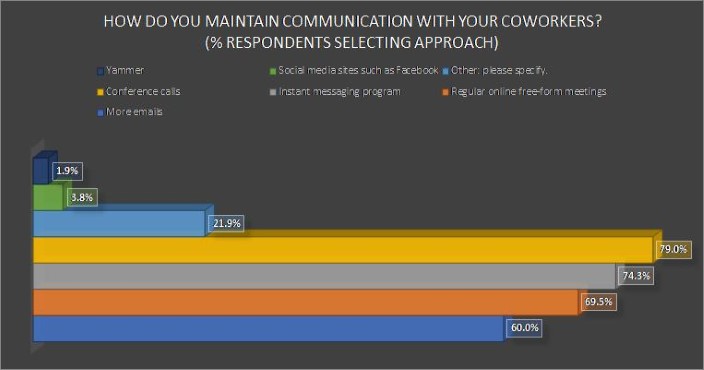
Responses to “Other”:
- Twelve respondents called out Microsoft Teams as an important tool: “The company uses MS Teams which is an excellent collaboration tool, and it includes audio, video, and instant messaging capabilities. It has made a BIG difference during this time when almost everyone is working virtually.”
- Five respondents noted the importance of phone calls: “With some co-workers, typically those I regularly engage with, I’ve resorted to just calling to catch up and to work through work-related issues.”
- Other respondents specified using Zoom, Skype, WhatsApp, Texting, more regularly scheduled staff meetings and free-form meetings over the phone.
- One respondent suggested weekly email reports of status and activities from each employee, with responses asking for clarification and explanation, and suggested calling employees at home as needed to just touch base.
- Hosting virtual “Happy Hours” and game nights open to all on the team was also suggested.
Vulnerability and Humor
Engaging fully in a remote work environment—even in the context of chat forums and virtual events—still requires a level of vulnerability we are not used to, and leaders can play a key role in fostering a new cultural norm.
Since starting work remotely, the number of people who have now seen the inside of my basement has increased 100-fold! My computer shares my desk with a sewing machine; and those papers on the wall … free weight exercise instructions that hang above the weight set just out of view. These visuals have prompted conversations with co-workers from mask patterns to exercise routines (or lack thereof). I have seen my co-worker’s cats, heard their dogs, and get an occasional glimpse of children running through the room. There is a new opportunity to bring more of ourselves to work, but it also requires us to get a little more comfortable with vulnerability. And don’t forget to have fun!
Once, I left my desk briefly while on a video call and left the camera on. My co-worker took a screenshot of my basement and set it as their virtual background. When I returned to the call, they were also in my basement! And on our next team call, everyone was in my basement! With intention, vulnerability, and humor, I am optimistic we will find new and surprising ways to continue our leadership and personal development in this new virtual work environment!
Challenges and Opportunities for Future Leaders, Author: Ravi Bhagat
Intro
For future leaders who have recently joined the workforce, you must recognize the way of going about nearly all aspects of your work will be different. Work routines, interactions, and development in a fully remote work environment will be far different from your prior experiences and established expectations. For those already a few years into your career, you will need to acknowledge the shift is especially great and you will need to embrace the change with patience and resiliency.
In the new remote environment, like most things that were taken for granted, achieving professional growth and development will take mindful attention and a proactive attitude. For me, short-term, quick-win efforts like developing a daily (or weekly) work routine and creating a productive home working space were great ways to start, but there’s so much more we can all do to confront challenges and seize opportunities in the new remote working environment.
Networking and Branding
The realities of the new remote working environment set in for me when I could not catch up with my team over a morning coffee, swing by a neighbor’s cubicle, or attend an in-person conference. These activities—either intentional or unintentional—help expand people networks, mature business acumen, and strengthen the collective knowledge base. Ultimately these actions contribute toward the progression of your career, and for future leaders, completing these simple activities in a remote work environment is a significant challenge.
Just as important as staying connected and developing strong relationships, future leaders should acknowledge the challenges remote work brings in building their brand. From my perspective, your brand defines who you are—your unique combination of experiences, skills, and intentions—and, more importantly, it provides the foundation by which people gain trust and comfort in working with you. For those who have already developed their brand, it’s critical to maintain it and continually build upon it. With the changing dynamics of our new environment, we all should spend a little time self-reflecting on our brand and how it is perceived by others.
Solutions—Role of Individual Business Case
I learned early in my career that utilizing a business case to articulate a value proposition was an effective tool. Using it for project planning shouldn’t come as a surprise, but you can use a business case as a tool for self-reflection. Zooming into this concept on an individual level, developing a compelling business case to articulate your skills, experiences, and differentiators is a powerful aid. For those unfamiliar with what a business case is, it is a document that captures the rationale and value proposition for taking on a project, initiative, or other task. A strong business case can help you achieve development in a remote work environment:
- Promote your value and goals: Drafting a business case helps you become aware of your uniqueness and value. Use it to develop an honest self portrait of yourself which in turn will allow you to have more sincere and genuine interactions. Define what you want to prioritize such as exam progress, learning a new computer language, or enrolling in an online class. When interactions are limited to conference calls or video teleconferencing, it is critical that you are authentic.
- Define shared connections: Since the typical routes that you would use to interact with others have vanished, drafting a personal business case to identify shared connections is helpful. For instance, I use an individual business case to recall shared experiences from prior projects, education, and past conferences so that I can strengthen connections. Ultimately developing these connections—even on non-traditional foundations—gives you a chance to get people excited about the future possibilities and deepening the connection.
- Level set expectations: Being realistic about your own expectations and objectives is key for having genuine interactions and furthering your own brand. Your individual business case becomes a tool to clearly communicate with your colleagues, managers, project team, and others what they can expect in terms of how you operate and the uniqueness you bring to the table. Then, deliver on those expectations. For instance, define realistic expectations for working hours and whether you need flexibility to manage work/life balance.
Teamwork and Collaboration
Our individual roles and responsibilities typically touch areas beyond our immediate team (or even our functional area), so staying connected and tuned-in is more than a best practice—it is an absolute imperative. The largely remote working environment that we are in makes it rather easy to fall into an insular state of being where your focus can be directed on singular tasks or individual goals. The challenge here is to keep a one-way street relationship from taking hold and to foster a collaborative team environment. Keep in mind that others on our teams (and even our managers) are going through similar challenges, and their sense of normalcy has been upended. Managing personal and team accountability when working through all that life (and work) has to offer is critical to advancing team goals. But beyond the sheer necessity of it, how can we do our part to increase the level of collaboration and accountability? Consider the role of open and honest communication.
Solutions—Role of an Open and Honest Communication Culture
Increasing the level of communication is critical to thriving in the new remote workplace environment. The frequency of status meetings has increased, corporate communications are weekly (if not more frequent), and “check-in” emails are now commonplace. While these are all positive changes that increase transparency and improve our teaming—what really will make the difference is the quality of our communications and the resulting culture that we help foster.

Responses to “Other”:
- Increased frequency of scheduled one-on-one meetings since there is no more wandering by desks.
- Regular group emails.
- Create a shared dashboard of current project items and deadlines.
- Avoid too frequent “status update” reports as they lead to non-insightful and repetitive information from week to week.
- Daily video check-in meetings along with weekly one-on-one video meetings with team members and stakeholders.
We all need to develop and embrace the new culture of open and honest communications. For instance, we all should lead by example by expanding our comfort zone in expressing work/life challenges, competing priorities, and objective concerns. This is not easy, but in doing so, we can encourage each other to do the same. The goal should be an uplifting culture that establishes an informal support system where the open communication acknowledges challenges, coupled with ways to overcome them either in the short-term or the long-term.
When you develop an open and honest communication culture, you’re enabling yourself and others to become more present at work and at home. When we allow others to understand our challenges and competing priorities, we don’t need to waste unnecessary time and effort trying to manage them in a vacuum. Ultimately, this allows you to stay focused (or keep focused) on the current moment instead of things going on behind the scenes or later in the day.
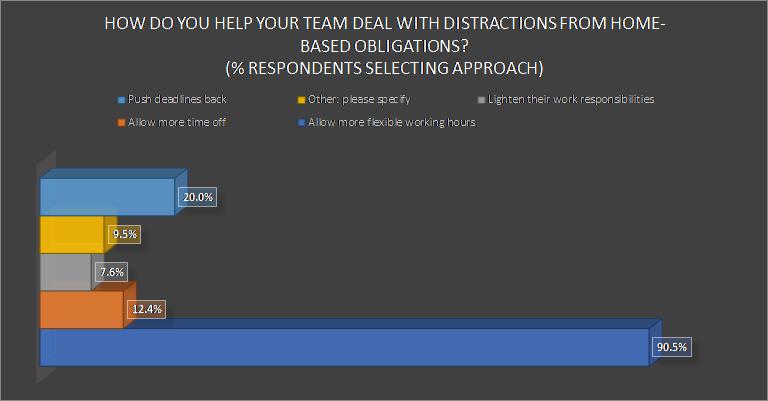
Responses to “Other”:
- Add resources to help.
- Communicate the importance of work/life balance and family responsibilities.
- Encourage use of vacation time, but also allow more rollover to 2021 than would normally be the case.
- Reduce the formality of tracking and managing.
- Be more flexible and predictable.
- “It has been as busy as ever with COVID creating additional reporting and forecasting demands for my team. We have been very flexible with work schedules, but in general people have been working more hours than they did when we were still working from the office.”
- “Plan ahead to avoid fire drills. Productivity hasn’t gone down for my team, part of it is that we usually have enough flexibility to rearrange our work hours.”
- “Recognize that each colleague has his/her own issues to manage and trust them to establish whatever patterns and habits work best. The proof is in the pudding—meaning if quality work is getting done on a timely basis, how and when it’s done (or who is watching) is of little consequence.”
- “Show empathy—very important. A lot of parents with young kids and understanding there are going to be interruptions is part of it. Judgment-free zone.”
Conclusion
There are several common technology-related problems that actuaries face in a remote working environment that need to be addressed by managers and company IT professionals. These include internet speed and reliability, access to home office files and programs, effective meeting management and personal office setup including monitors, desks and chairs. These items are reasonably simple to solve from a technology standpoint, and, although they may incur an initial cost, will result in better performance and collaboration by the employees.
The more difficult issues in a remote work environment are human-related. By encouraging and facilitating employees’ ability to be intentional and vulnerable, and bringing humor into the work environment, leaders can help employees find ways to break down barriers and enhance communications and connections.
Leaders can help their employees by establishing chat rooms and, virtual study groups, and by hosting virtual social events with senior leaders invited to participate. The organization can become more personal and familiar and develop stronger collaboration by doing so.
The responsibility doesn’t just lie with current leaders, though. Future leaders need to recognize their role to promote their personal brand and act with intention to establish networks and partnerships. Employees need to work with their managers to define realistic expectations for work hours and work/life balance, and leverage that by managing personal and team accountability. Employees need to pay attention to being present and engaged while at work if they desire to progress.
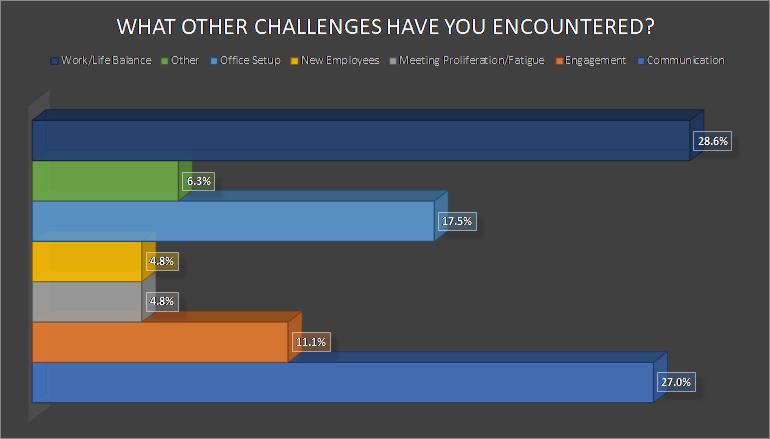
Selected Comments (63 Responses):
- “Generally relied very heavily on instant messaging programs with calling capabilities.”
- “I find the discussion and engagement in virtual meetings to not be as effective as in-person meetings. One way I try to address this is by calling on specific people to get input and get the discussion moving. I also think having video often helps improve the engagement level, though some people don’t like to use video.”
- “Patience, patience, and patience ... .”
- “I try to be online during regular hours and respond to questions quickly. However, most of my day is spent in meetings, which makes me less available to employees. So, I sometimes ask another senior employee to step in and help the new employee. This way he doesn’t have to wait hours before I can get to him.”
- “Solutions to go paperless—ranging from coming up with electronic solutions, working with regulators.”
- “The most surprising challenge was that many of our clients couldn’t return signed reliance letters because they didn’t have scanners or fax machines at their homes—we ended up having them take a photo of the signed letter on their phone and send us the picture.”
- “Clarify with family when I need to be focused on work, and vice versa; lots of communication; maintain consolidated calendars.”
- “Family and work life blurring—set boundaries. Don't do email during family time.”
- “When working from home, everyone faces challenges and distractions throughout the day. For me the key is recognizing that and allowing your employees to deal with them as they see fit. As long as employees are productive, meeting deadlines, and attending meetings, then I am comfortable with each employee being responsible for their own schedule.”
James Clark, FSA, MAAA, is vice president of Risk Management for LifeMap. He can be contacted at jim.clark@lifemapco.com.
